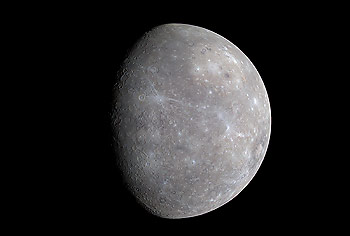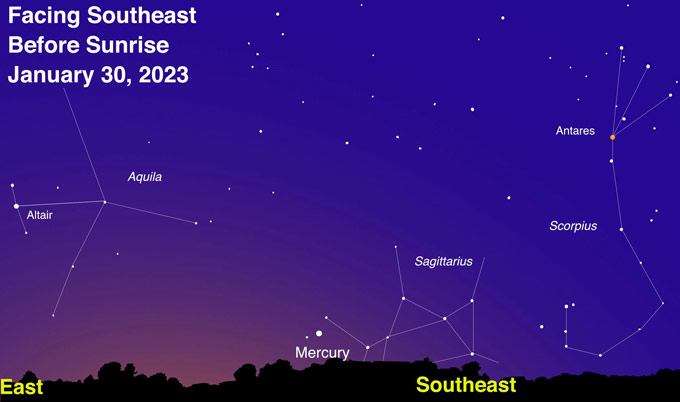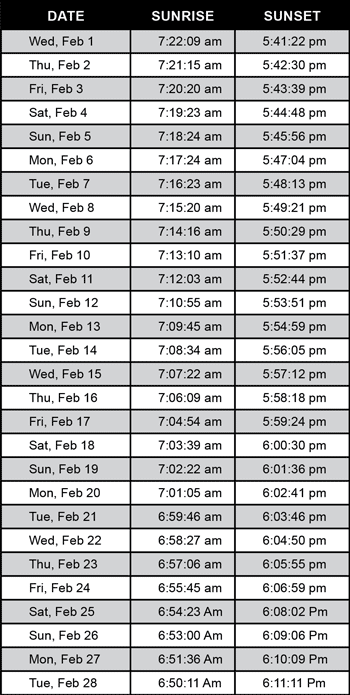DARK SKY HAPPENINGS - February 2023
Moab
UT (at City Hall)
38O34’ N Latitude
109O33’ W Longitude
4048 ft - 1234 m |
Spot the Messenger: Observe Mercury
David Prosper - Nasa Night Sky Note
This article is distributed by NASA’s Night Sky Network (NSN).
The NSN program supports astronomy clubs across the USA dedicated to astronomy outreach. Visit nightsky.jpl.nasa.gov to find local clubs, events, and more!
 |
| Mercury reaches maximum western elongation on the morning of January 30, which means that your best chance to spot it is right before sunrise that day! Look for Mercury towards the southeast and find the clearest horizon you can. Observers located in more southern latitudes of the Northern Hemisphere have an advantage when observing Mercury as it will be a bit higher in the sky from their location, but it’s worth a try no matter where you live. Binoculars will help pick out Mercury’s elusive light from the pre-dawn glow of the Sun. Image created with assistance from Stellarium |
Most planets are easy to spot in the night sky, but have you spotted Mercury? Nicknamed the Messenger for its speed, Mercury is also the closest planet to the Sun. Its swift movements close to our Sun accorded it special importance to ancient observers, while also making detailed study difficult. However, recent missions to Mercury have resulted in amazing discoveries.
Mercury can be one of the brightest planets in the sky – but also easy to miss! Since it orbits so close to the Sun, observing Mercury is tricky. That’s why prime Mercury viewing happens either right before sunrise or right after sunset when the Sun is blocked by the horizon. Mercury’s small size means a telescope is needed to observe its phases since they can’t be discerned with your unaided eye. However, if you want to observe Mercury with your telescope, be extremely careful of the Sun, which can destroy your equipment and permanently blind you as well!
Despite being a small and seemingly barren world, Mercury is full of interesting features. It’s one of the four rocky (or terrestrial) planets in our solar system. Mercury is the smallest planet in our solar system and possesses the most eccentric, or non-circular, orbit of any planet as well. Surprisingly, Mercury is not the hottest planet in our solar system; that honor goes to Venus, courtesy its thick shroud of carbon dioxide. Since Mercury lacks a substantial atmosphere and the insulating properties a layer of thick air brings to a planet, its temperature swings wildly between a daytime temperature of 800 degrees Fahrenheit (427 degrees Celsius) and -290 degrees Fahrenheit (-179 degrees Celsius) at night.
NASA’s Mariner 10 was Mercury’s first robotic explorer. Decades later, NASA’s MESSENGER first visited Mercury in 2008. MESSENGER studied and mapped the planet before smashing into Mercury at mission’s end in 2015. Since MESSENGER, Mercury was briefly visited by BepiColombo, which first flew by in 2021 and is expected to enter orbit in 2025. Check out NASA’s discoveries and science about Mercury at solarsystem.nasa.gov/mercury/, and visit the rest of the universe at nasa.gov.
 |
Mercury is hot, small, and heavily cratered across its gray surface, as seen in this image from NASA MESSENGER. Mercury is the most heavily cratered planet in our solar system since it lacks either a substantial atmosphere or geologic activity to erode surface features like craters - similar in certain aspects to the surface of our own Moon.
Credit: NASA/Johns Hopkins University Applied Physics Laboratory/Carnegie Source: https://solarsystem.nasa.gov/resources/439/mercurys-subtle-colors/ |
Sunrise-Sunset
(The time of sunrise and sunset assumes a flat horizon. Actual time may
vary depending upon the landscape.) |
 |
MOON HAPPENINGS
Jan 6 - Full Moon at 4:09pm
Jan 14 - Last Quarter at 7:13pm
Jan 21 - New Moon at 1:55pm
Jan 28 - First Quarter at 8:20am
|
Moab Dark Skies mission is to promote the appreciation and conservation of Moab’s valuable and rare dark skies. Moab Dark Skies was established by the Friends of Arches and Canyonlands Parks in conjunction with the National Park Service and Utah State Parks Division of Natural Resources
For more information, check out our Facebook page. |
|